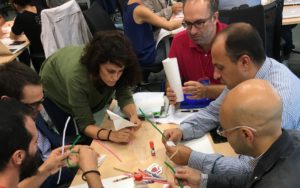RESOURCES
Big Idea: Collaboration
 Effective collaboration is considered a critical factor for success in school, work, and life. But how much time do we spend thinking about what makes effective collaboration and how it intersects with other concepts such as personalization and competition? As is the case with all Big Ideas there is a lot to learn by exploring the concept of collaboration. And what better what to explore collaboration than to embed it in a challenge?
Effective collaboration is considered a critical factor for success in school, work, and life. But how much time do we spend thinking about what makes effective collaboration and how it intersects with other concepts such as personalization and competition? As is the case with all Big Ideas there is a lot to learn by exploring the concept of collaboration. And what better what to explore collaboration than to embed it in a challenge?
ENGAGE
Big Idea: Collaboration
Essential Question: How do we build and sustain effective collaboration?
Challenge: Solve a problem through collaboration!
Sample Guiding Questions
These are only example questions we encourage you to ask as many personal and contextual questions as possible.
- What is collaboration?
- What is the difference between coordinating, cooperating and collaborating?
- Why should we collaborate?
- Why is it hard to collaborate?
- What is the role of collaboration in learning?
- What is the role of collaboration in the workplace?
- What is the role of the individual in collaboration?
- What is needed for successful collaboration?
- What inhibits collaboration?
- What is the role of technology in collaboration?
- Are collaboration and competition mutually exclusive?
- What does science tell us about collaboration?
- What does history tell us about collaboration?
- Can there be too much collaboration?
- Etc.
*Once you brainstorm all of the questions organize and prioritize them.
INVESTIGATE
Guiding Activities and Resources
These are only a set of example activities and resources and the learners will need to evaluate the quality of the content. They are not verified or necessarily supported, just examples. The ones that you choose should be in direct relationship to your specific guiding questions and context. Activities and resources for adults, adolescents, and younger children will be different. The goal is to develop solutions that mean something in your community and are sustainable.
Example Activities
- Explore the definition of collaboration.
- Explore the similarities and differences between collaboration, cooperation, coordination and teamwork
- Reflect on past collaborative projects and
- Identify behaviors that supported collaboration
- Identify factors that inhibited collaboration.
- Research the psychology of collaboration
- Explore the meaning of collaboration in science
- Explore the literature on collaborative and cooperative learning
- Etc.
Example Resources
- Children Must Be Taught to Collaborate, Studies Say
- The Power of Collaboration
- Collaboration Skills
- Collaborative Overload
- Etc.
Synthesis
Using the research findings from your Investigations develop a synthesis that demonstrates a clear understanding of the challenge. For help with creating a synthesis explore this resource.
Solution Prototypes – Using your research synthesis create multiple ideas for solutions and review each one to make sure your research supports it. Share the prototypes with various stakeholders and get feedback.
Solution – with the feedback from the stakeholders develop one solution that has the most potential for success.
ACT
Implement – Develop a plan to implement the solution with the stakeholders and collect data about the impact.
Evaluate – Using quantitative and qualitative measures determine if the solution is valid and what can be improved.
REFLECT, DOCUMENT, AND SHARE
Throughout the experience take time to document the events and reflect on what is happening to build on prior knowledge and identify future questions.
Share what you learned with your local community and the world. Use #CBLWorld on social media.
